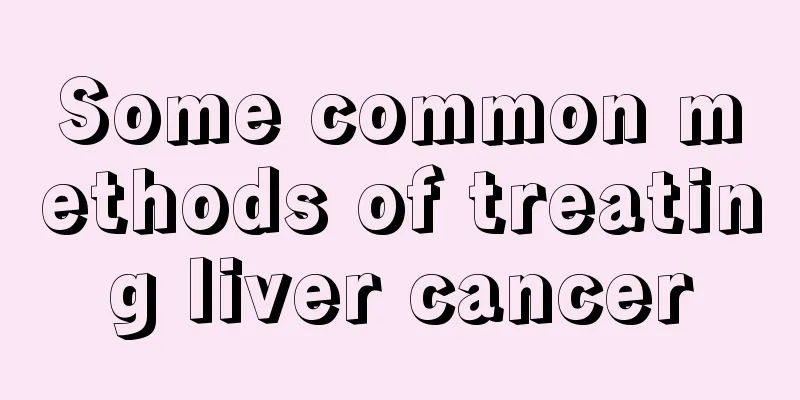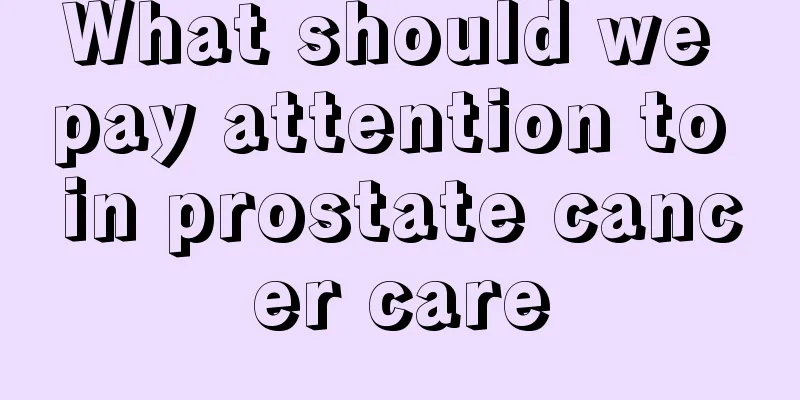To treat prostatitis, try these methods

|
The prostate is a gland unique to men, shaped like a chestnut. Many people believe that eating hairy chestnuts can nourish the prostate. The prostate is an important male organ and is closely related to human urination. When suffering from prostatitis, not only should you not smoke or drink, but you should also not eat many spicy and irritating foods. Prostatitis can also cause symptoms such as frequent urination and painful urination. 1. Antimicrobial therapy The discovery of the causative pathogen in prostatic fluid culture is the basis for selecting antimicrobial therapy. If patients with non-bacterial prostatitis have signs of bacterial infection and general treatment is ineffective, they can also be treated with appropriate antibacterial drugs. When choosing antimicrobial drugs, it is necessary to pay attention to the existence of a prostate-blood barrier composed of lipid membranes between the prostate acini and the microcirculation. The barrier hinders the passage of water-soluble antibiotics, greatly reducing the therapeutic effect. When prostate stones are present, they can serve as harborages for bacteria. The above factors make chronic bacterial prostatitis difficult to treat, requiring a long course of treatment and prone to relapse. Currently, quinolone drugs such as ofloxacin or levofloxacin are more recommended. If ineffective, continue for 8 weeks. If the disease relapses and the bacterial species remains unchanged, switch to a preventive dose to reduce acute attacks and alleviate symptoms. If long-term use of antibiotics induces serious side effects, such as pseudomembranous colitis, diarrhea, and the growth of drug-resistant intestinal strains, the treatment plan needs to be changed. There is still controversy in clinical practice as to whether nonbacterial prostatitis is suitable for treatment with antibiotics. Patients with "bacterial" prostatitis can also use drugs that are effective against bacteria and mycoplasmas, such as quinolones, SMZ-TMP or TMP alone, in combination with tetracyclines and quinolones or in intervals. If antibiotic treatment is ineffective and it is confirmed to be aseptic prostatitis, antibiotic treatment should be discontinued. In addition, the treatment goal can be achieved by using a double-balloon catheter to block the prostatic urethra and injecting antibiotic solution from the urethral cavity and then reflux it into the prostatic duct. Type I is mainly treated with broad-spectrum antibiotics, symptomatic treatment, and supportive care. For type II, oral antibiotics are recommended as the main treatment, and sensitive drugs should be selected. The course of treatment is 4 to 6 weeks, during which the patient's efficacy should be evaluated periodically. Type III patients can take oral antibiotics for 2 to 4 weeks and then evaluate the efficacy. At the same time, nonsteroidal anti-inflammatory drugs, α receptor antagonists, M receptor antagonists, etc. are used to improve urination symptoms and pain. Type IV requires no treatment. 2. Anti-inflammatory and analgesic drugs Non-steroidal anti-inflammatory drugs can improve symptoms. Generally, indomethacin is used orally or as suppositories. Traditional Chinese medicine that uses anti-inflammatory, heat-clearing, detoxifying and hard-hardening drugs also has certain effects. Allopurinol can reduce the concentration of uric acid in the whole body and prostatic fluid. In theory, it can act as a free radical scavenger and can also remove reactive oxygen components, reduce inflammation, and relieve pain. It can be regarded as an optional auxiliary treatment method. 3. Physical therapy Prostate massage can empty the concentrated secretions in the prostate ducts and drain the infected foci in the obstructed areas of the glands. Therefore, for stubborn cases, prostate massage can be performed every 3 to 7 days while using antibiotics. A variety of physical factors are used for prostate therapy, such as microwave, radio frequency, ultrashort wave, medium wave and hot water sitz bath, which are beneficial for relaxing the prostate, posterior urethral smooth muscle and pelvic floor muscle, enhancing antibacterial effect and relieving pain symptoms. 4.M receptor antagonists M receptor antagonists can be used to treat prostatitis in patients with symptoms of overactive bladder, such as urgency, frequency, and nocturia, but without urinary tract obstruction. 5. Alpha receptor antagonists Patients with prostatitis, bacterial or non-bacterial prostatitis have increased tension in the prostate, bladder neck and urethral smooth muscles. During urination, the increased intraurethral pressure causes urine to flow back into the prostatic duct, which is an important cause of prostatitis, prostatic stones and bacterial prostatitis. The use of α-receptor antagonists can effectively improve prostatitis and urination symptoms, help prevent urine reflux into the prostate, and are of great significance in preventing recurrence of infection. It also plays an important role in the treatment of type III prostatitis. Alpha receptor antagonists should be used for a longer course of treatment to allow sufficient time to adjust smooth muscle function and consolidate the therapeutic effect. Different alpha receptor blockers can be selected according to the patient's condition, mainly including: doxazosin, naftopidil, tamsulosin and terazosin. 6. Prostate massage and heat therapy Prostate massage is one of the traditional treatment methods. Studies have shown that proper prostate massage can promote the emptying of the prostate duct, increase local drug concentration, and thus relieve the clinical symptoms of chronic prostatitis. Hyperthermia therapy mainly utilizes the thermal effects produced by a variety of physical means to increase blood circulation in prostate tissue, accelerate metabolism, help eliminate tissue edema, and relieve pelvic floor muscle spasms. 7. Surgery Surgical treatment may be used for recurrent chronic bacterial prostatitis. Prostatectomy can be a cure, but it should be used with caution. Because prostatitis usually involves the peripheral zone of the gland, transurethral resection of the prostate (TURP) is difficult to achieve the purpose of treatment. TURP can remove prostate stones and bacterially infected lesions near the prostate ducts, helping to reduce reinfection of peripheral zone lesions. 8. Other treatments It includes biofeedback therapy, transperineal extracorporeal shock wave therapy, psychotherapy, traditional Chinese medicine treatment, etc. |
<<: How to treat tinnitus and blockage in the ears?
>>: Do you have any symptoms of heart qi deficiency?
Recommend
What are the treatment methods for lung cancer? Analysis of the effect of TCM in assisting the treatment of lung cancer
Lung cancer is a very serious disease. It threate...
Can I cut off the skin tags myself? Care is especially important
Skin tags are a common disease, which some people...
How to treat gallbladder polyps?
The clinical manifestations of gallbladder polyps...
Can white spots on the face be contagious to other people?
The appearance of white spots on the face may be ...
People who often skip breakfast are prone to six diseases
White-collar workers are busy working all day and...
How to store coffee beans
As coffee becomes known to more and more people, ...
Can the mole on the corner of the mouth be removed
Many people feel inferior and lack confidence in ...
The role of RNA
I think everyone should be familiar with RNA. It ...
What are the early detection methods for liver cancer? Introduction to early detection methods for liver cancer
Liver cancer is a malignant tumor. Early detectio...
Is blood pressure 80100 normal?
After middle age, blood pressure levels are prone...
Can a razor shave underarm hair?
Can a razor be used to shave underarm hair? Many ...
The difference between toner and softener
Female friends must use lotion in their daily liv...
How is oral lichen planus treated?
Oral lichen planus is a relatively common oral di...
Prevention and treatment of foodborne parasitic diseases
Foodborne parasitic diseases mainly occur in chil...
Why do hair get lice
Many people have experienced lice as children. Th...









